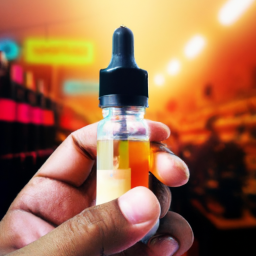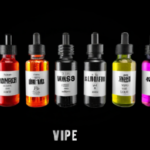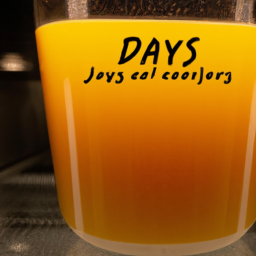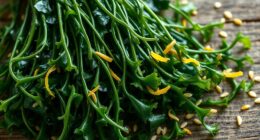At first, I thought vaping was all about creating big clouds and looking cool. But as I delved deeper into the vaping world, I realized it involves so much more. It includes experimenting with different flavors and creating unique blends. This is where the real fun begins.
If you’re like me and you’re tired of the same old boring flavors, then it’s time to learn how to flavor vape juice. Sure, you could buy pre-made flavors, but where’s the fun in that? It’s like eating at a fast food chain instead of cooking your own meal.
With a little bit of knowledge and some experimentation, you can create delicious and unique flavors that will leave your taste buds begging for more. So, let’s dive in and learn how to flavor vape juice like a pro.
Key Takeaways
- Choosing high-quality flavorings and understanding concentration levels is crucial for achieving desired flavor intensity.
- Testing flavor concoctions through dripping, steeping, and smelling is essential for achieving the desired taste.
- Proper storage conditions such as cool temperatures and avoiding exposure to light can help extend the shelf life of vape juice.
- Experimenting with advanced techniques such as steeping and adding sweeteners can enhance flavor intensity.
Understanding the Basics of Vape Juice
So, you wanna know the basics of vape juice? Well, let me tell you, the first thing you need to understand is that it’s the liquid that gets vaporized in your device to create those delicious clouds.
But before you start mixing your own flavors, it’s important to think about vaping safety. Make sure you’re using high-quality ingredients and clean equipment to avoid any potential health hazards.
Choosing the right base is also crucial when it comes to making vape juice. The two most common bases are propylene glycol (PG) and vegetable glycerin (VG). PG is thinner and produces less vapor but provides a better throat hit, while VG is thicker and produces more vapor but has a sweeter taste. You can also choose a mix of both to get the best of both worlds.
Now that you understand the basics, let’s move on to choosing the right flavorings.
Choosing the Right Flavorings
When it comes to choosing the right flavorings for your vape juice, there are a few key points to keep in mind.
First and foremost, it’s important to experiment with different flavors to find the perfect combination for your taste buds.
Additionally, it’s important to find reliable sources for your flavorings to ensure quality and safety.
Finally, understanding concentration levels is crucial in order to achieve the desired flavor intensity.
As someone who’s experimented with many different flavorings, I can attest to the importance of these factors in creating a delicious and satisfying vape juice.
Experimenting with Different Flavors
To really explore the different flavors available, I highly recommend experimenting with different vape juice flavors. One way to do this is by trying out different flavor combination ideas. You can mix and match different flavors to create unique and delicious e-juice blends.
For example, you can try combining fruity flavors like strawberry and mango, or mix dessert flavors like vanilla and chocolate. When experimenting with flavor combinations, taste testing is key. Start by mixing small batches of e-juice and adjust the flavorings as needed.
Don’t be afraid to try out new combinations and take notes on what works and what doesn’t. Remember, taste is subjective, so what may work for one person may not work for another. By testing and experimenting different flavors, you can create a blend that perfectly suits your taste buds.
In order to continue creating unique vape juice flavors, it’s important to find reliable sources for flavorings. There are many options available, from online retailers to brick-and-mortar stores. I’ll discuss this further in the next section.
Finding Reliable Sources for Flavorings
You can easily find trustworthy sources for the ingredients needed to create unique e-juice blends by researching reviews and ratings from other DIY mixologists. Choosing quality ingredients is crucial in achieving a well-balanced and flavorful e-juice.
When searching for flavorings, it is essential to compare different brands and their offerings. Some brands may use artificial flavorings, while others use natural ingredients. It’s important to determine which type of flavorings you prefer and which ones work best for your recipe.
When comparing different flavor brands, it’s also important to consider the concentration levels of each flavoring. Some brands may have a higher concentration level than others, which can affect the overall taste of your e-juice. Understanding concentration levels is crucial in creating a balanced and flavorful e-juice.
In the next section, we’ll discuss how to measure and adjust concentration levels to achieve the desired taste.
Understanding Concentration Levels
Understanding concentration levels is crucial for achieving a perfectly balanced and delicious e-liquid blend, ensuring that every puff is a satisfying and enjoyable experience. To fully comprehend concentration levels, it’s important to understand dilution ratios. Dilution ratios tell us how much flavoring to add to our base liquid.
Typically, the dilution ratio for flavorings ranges from 5% to 20%, depending on the manufacturer’s recommendation. However, it’s always best to start with a lower concentration level and gradually increase it until you find the perfect balance for your taste buds.
Measuring flavoring accurately is also essential for creating a consistent and flavorful e-liquid blend. When measuring flavoring, it’s crucial to use precise and accurate tools such as syringes or droppers. Using a scale can also be helpful, especially when dealing with smaller quantities.
Additionally, it’s important to take note of the flavoring’s specific gravity, which is the ratio of its density to the density of water. Understanding concentration levels and measuring flavoring accurately are just some of the crucial steps in creating a delicious vape juice blend.
Next, we’ll dive into the process of mixing your own vape juice.
Mixing Your Own Vape Juice
Mixing your own vape juice is like being a mad scientist in a laboratory, concocting the perfect flavor combination. With DIY vape juice, you have the freedom to customize flavors to your liking and create unique blends that cannot be found in stores. However, before you start mixing, it is important to have a basic understanding of the ingredients and tools you will need.
To create your own vape juice, you will need four main components: a base liquid, flavor concentrates, nicotine (if desired), and bottles for mixing and storing. The base liquid is typically a mixture of propylene glycol (PG) and vegetable glycerin (VG), which serve as the foundation for your flavor and vapor production. Flavor concentrates are the key to creating unique flavors, and there are countless options available on the market. When selecting flavors, it is important to consider the concentration level and how it will affect the final product. To help you get started, here is a table of some popular flavor combinations:
| Flavor | Concentration (in %) | Recommended Pairings | Notes |
|---|---|---|---|
| Blueberry | 5-7 | Lemon, Cream, Vanilla | Can be overpowering, start with a small amount and adjust as needed |
| Watermelon | 8-10 | Strawberry, Kiwi, Mint | Can be sweet, balance with a tart flavor |
| Caramel | 10-12 | Hazelnut, Coffee, Tobacco | Can be used as a base for dessert flavors |
| Menthol | 1-3 | Fruit, Mint, Vanilla | Can be overpowering, start with a small amount and adjust as needed |
Once you have your ingredients and tools, it is time to start mixing and experimenting with flavors. But before you do, it is important to test your flavor and make adjustments as needed.
Testing Your Flavor
Before diving into the world of DIY vape juice, it’s crucial to ensure your flavor concoctions are up to par by conducting a taste test and making necessary adjustments.
Here are three flavor testing methods that can help you achieve your desired taste:
-
Dripping Test – This method involves dripping a small amount of your flavored vape juice onto your atomizer and inhaling to test the flavor. This is an effective way to get a quick taste of your flavor, but it can be wasteful and time-consuming.
-
Steeping Test – Steeping your vape juice involves letting it sit for a few days or weeks to allow the flavors to blend and mature. This method is ideal for achieving a more complex flavor profile and can help enhance the overall taste of your juice.
-
Smell Test – Your sense of smell plays a crucial role in your ability to taste flavors. Before testing your vape juice, take a moment to smell it and note any aromas or scents. This can help you identify any off-notes or flavors that need to be adjusted.
Once you’ve tested and adjusted your flavor, it’s time to move on to storing your flavored vape juice.
Storing Your Flavored Vape Juice
When it comes to storing your flavored vape juice, there are a few key points to keep in mind. First and foremost, choosing the right storage container is crucial. Glass or plastic bottles with tight-fitting caps are ideal for keeping your juice fresh and free from contaminants.
Additionally, proper storage conditions such as cool temperatures and avoiding exposure to light can help extend the shelf life of your juice. As someone who’s experimented with many different flavors, I’ve found that taking care in how I store my juice can make a significant difference in its quality and taste.
Choosing the Right Storage Container
Properly storing your vape juice is crucial to maintain its quality and flavor, so it’s important to select the appropriate container. When it comes to choosing the right material for storage container, it’s important to consider the following:
-
Glass: This is a great option for storage containers as it doesn’t react with the vape juice, ensuring the flavor isn’t affected. Glass containers are also easy to clean and can be reused multiple times.
-
Plastic: If you prefer plastic containers, make sure to choose one that’s made from food-grade plastic. It’s important to note that some plastic containers can interact with certain ingredients in the vape juice, potentially altering the flavor.
-
Metal: Metal containers are not recommended for storing vape juice as they can react with the liquid, leading to a metallic taste. However, if you must use a metal container, make sure it’s made from stainless steel to prevent any chemical reactions.
Proper sealing of storage container is also important to prevent air and sunlight from affecting the flavor of your vape juice.
In the next section, we’ll discuss the proper storage conditions to ensure your vape juice remains fresh and flavorful.
Proper Storage Conditions
Maintaining the quality of your liquid requires a suitable environment that shields it from light and air. Proper storage conditions are essential to ensuring your flavored vape juice doesn’t lose its taste or potency.
Temperature control is crucial in preserving the quality of your juice. Heat can degrade the flavors and nicotine in your vape juice, which can lead to a less enjoyable vaping experience. Therefore, it’s best to store your e-liquid in a cool, dry place away from direct sunlight.
Air exposure is another factor that can cause your vape juice to lose its taste and quality. When exposed to air, the flavors in your e-liquid can break down and become less potent. To prevent air exposure, make sure that your storage container is tightly sealed. You can also consider storing your vape juice in smaller bottles to minimize the amount of air that comes in contact with the liquid.
By following these proper storage conditions, you can ensure that your flavored vape juice stays fresh and delicious for longer. This leads us to the next section about the shelf life of flavored vape juice.
Shelf Life of Flavored Vape Juice
To keep your e-liquid fresh, you should be aware that its shelf life can vary depending on the ingredients used. Flavored vape juice ingredients, such as fruit concentrates or natural extracts, can cause the liquid to degrade faster and shorten its shelf life. On the other hand, synthetic flavorings tend to be more stable and can last longer.
Another factor that affects the shelf life of flavored vape juice is temperature. Exposure to high heat can cause the ingredients to break down and lose their potency, resulting in a change in flavor and color. For example, if you leave your e-liquid bottle in a hot car or near a heater, it can go bad much quicker than if you store it in a cool, dark place. To ensure the longevity of your flavored vape juice, it is recommended to store it in a cool, dry place away from direct sunlight and heat sources.
By taking proper storage precautions, you can extend the shelf life of your flavored vape juice and enjoy its full flavor and potency for longer. Now that you know how to properly store your e-liquid, let’s move on to the next section and learn how to use it.
Using Your Flavored Vape Juice
As I prepare to use my newly flavored vape juice, there are a few key points to keep in mind. Firstly, I’ll need to fill my tank or cartridge with the desired amount of liquid.
Secondly, I may need to adjust my device settings to ensure optimal performance.
And finally, I can sit back and enjoy the unique flavor that I’ve created, savoring every puff.
With these steps in mind, I’m ready to fully experience the delicious taste of my homemade vape juice.
Filling Your Tank or Cartridge
First, make sure you have properly filled your tank or cartridge with your desired flavor of vape juice. The process of filling your tank or cartridge can vary depending on the type of device you have. For example, some tanks have a top-fill design, while others require you to unscrew the bottom to fill. Regardless of the design, it’s important to follow the manufacturer’s instructions and ensure that the tank or cartridge is not overfilled.
To help you get started with filling your tank or cartridge, here is a table outlining some common cleaning techniques and troubleshooting tips for your device:
| Cleaning Techniques | Troubleshooting Tips |
|---|---|
| Use a cotton swab and rubbing alcohol to clean the contacts and threading of your device | If your device is not producing vapor, check the battery to make sure it is charged and turned on |
| Disassemble your tank or cartridge and wash all components in warm, soapy water | If you are experiencing a burnt taste, check the coil to make sure it is properly installed and not worn out |
| Use a specialized cleaning solution to remove stubborn residue from your tank or cartridge | If you are having difficulty drawing air through your device, check the airflow control to make sure it is open |
Now that you have properly filled your tank or cartridge and have some cleaning and troubleshooting techniques under your belt, it’s time to adjust your device settings to enhance your vaping experience.
Adjusting Your Device Settings
Once you’ve filled your tank or cartridge and cleaned your device, it’s time to adjust your device settings to customize your vaping experience.
One of the key ways to do this is by adjusting the wattage. This determines how much power is sent to the coil, which affects the temperature of the coil and the vapor produced. Higher wattages produce hotter vapor and more clouds, while lower wattages produce cooler vapor and less clouds. It’s important to find the right wattage for your vape juice and preferences.
Another way to customize your vaping experience is through temperature control. This allows you to set a specific temperature for the coil, which can affect the flavor and vapor production. Temperature control is especially helpful for those who use certain types of coils, such as nickel or titanium, which can be sensitive to high temperatures. By adjusting the temperature, you can avoid burning your coil and enjoy a smoother vaping experience.
Once you’ve adjusted your device settings, it’s time to enjoy your unique flavor and vaping experience.
Enjoying Your Unique Flavor
To truly savor the unique taste of your e-liquid, you should take slow and deliberate draws from your device. This allows the flavors to fully develop on your taste buds.
Pairing flavors can enhance your vaping experience even more. For example, if you have a fruity flavor, consider adding a hint of menthol for a refreshing twist. Or, mix a dessert flavor with a coffee flavor for a delicious treat.
Another way to enhance your vaping experience is to experiment with different wattage and temperature settings on your device. Higher wattage and temperature can bring out bolder flavors, while lower settings can bring out more subtle nuances. Just be sure to start with lower settings and gradually increase to avoid burning your coil.
Now that you know how to enjoy your unique flavor, it’s important to keep your equipment clean to maintain optimal performance.
Cleaning Your Equipment
Don’t let your equipment become a neglected garden; regularly tending to it will ensure your vape juice flavors bloom to their fullest potential.
Cleaning your equipment is crucial to maintaining the quality of your vape juice. Here are some cleaning methods you can use and how often you should clean your equipment:
- Use warm water and soap to clean your tank and drip tip after each use.
- Soak your tank and coils in vodka or distilled water once a week to remove any buildup.
- Clean your battery contacts once a month with rubbing alcohol to prevent corrosion.
- Disassemble your equipment and deep clean it every three months to remove any stubborn residue.
By following these cleaning methods and frequency of cleaning, not only will your vape juice taste better, but your equipment will also last longer.
Now that your equipment is clean and ready to go, it’s time to experiment with advanced techniques to take your vape juice flavors to the next level.
Experimenting with Advanced Techniques
Now that you’ve tended to your equipment, it’s time to push the boundaries and elevate your taste experience with some advanced techniques that’ll leave you feeling satisfied and fulfilled.
One way to enhance the flavor of your vape juice is by experimenting with different flavoring methods. For instance, steeping your e-liquid over time can help to intensify its flavor. This involves leaving your vape juice in a cool, dark place for a few days or even weeks, allowing the flavors to meld and develop.
Another way to boost flavor intensity is by adding sweeteners to your e-liquid. However, it’s important to choose the right sweetener to avoid ruining the taste of your juice. Steer clear of sugar-based sweeteners, as they can clog your atomizer and damage your coils. Instead, opt for natural sweeteners like stevia or sucralose, which won’t affect your juice’s viscosity.
By experimenting with these advanced flavoring techniques, you can create a truly mouth-watering vape juice that’ll satisfy your cravings.
When troubleshooting common issues, it’s important to approach the problem systematically and methodically.
Troubleshooting Common Issues
First, if you encounter any frustrating faults with your vaping, fear not as there are several simple solutions. One of the most common issues is a clogged atomizer, which can be fixed by cleaning or replacing the coil. If you notice a burnt taste or reduced vapor production, it may be time to switch out the coil or clean the atomizer. Another issue may be with the nicotine level, which can be adjusted to better suit your preferences. If you find that your vape juice is too strong or too weak, try adding or subtracting nicotine to find the perfect balance.
To help you troubleshoot common issues, refer to the table below for quick solutions:
| Issue | Solution |
|---|---|
| Clogged atomizer | Clean or replace coil |
| Burnt taste or reduced vapor production | Replace coil or clean atomizer |
| Too strong or too weak nicotine | Adjust nicotine levels |
By following these simple solutions and adjusting your nicotine levels, you can customize your vaping experience to your liking and avoid any frustrating issues. Remember to always stay informed and experiment with different techniques to find what works best for you.
Frequently Asked Questions
Can you use essential oils in vape juice?
I don’t recommend using essential oils in vape juice. They are not intended for inhalation and can be harmful. Instead, consider using essential oil alternatives specifically designed for vaping and follow proper dilution guidelines to ensure a safe and enjoyable experience.
What are the best flavor combinations for vape juice?
As a seasoned vape enthusiast, I recommend experimenting with fruit and menthol combinations like strawberry and mint or blueberry and menthol. For sweet and savory pairings, try vanilla and caramel or cinnamon and apple.
How long does it take for a new flavor to fully develop in the vape juice?
Flavor maturation is the process of allowing the ingredients in vape juice to fully develop and meld together. This can take anywhere from a few days to several weeks, depending on the recipe and steeping process used.
Is it safe to vape homemade flavorings?
As an AI language model, I cannot provide personal opinions or advice. However, it is important to note that vaping risks can increase when using DIY flavorings, as these may contain unknown ingredients that could be harmful when heated and inhaled. It is recommended to use reputable, tested flavorings.
Are there any health risks associated with vaping flavored juice?
Research findings suggest that flavored vape juice can potentially harm the lungs, although more studies are needed. Alternative options include using flavor extracts, which are safer but require more skill to mix accurately.
Conclusion
In conclusion, flavoring vape juice is a fun and exciting process that allows you to customize your vaping experience. With the right knowledge and tools, anyone can create a delicious and unique vape juice flavor.
As I’ve learned through my own experience, understanding the basics of vape juice and choosing the right flavorings are essential steps in creating a well-balanced flavor. It’s important to remember to properly store your flavored vape juice and regularly clean your equipment to maintain the quality and taste.
As the saying goes, "practice makes perfect,"and experimenting with advanced techniques can lead to even more flavor possibilities. Don’t be afraid to get creative and try out new flavor combinations. Who knows, you may even discover your own signature vape juice flavor.
Happy vaping!
Ilana has been a vegan for over 10 years. She originally made the switch for health reasons, but soon found herself becoming more and more passionate about the ethical and environmental implications of a vegan lifestyle. Ilana is the author of The Graceful Kitchen, a blog all about veganism. She loves to cook up delicious and nutritious vegan meals, and share her recipes with others who are interested in leading a cruelty-free life. Ilana is also a strong advocate for using whole foods as the foundation of a healthy diet, and believes that going vegan is one of the best ways to achieve this.















